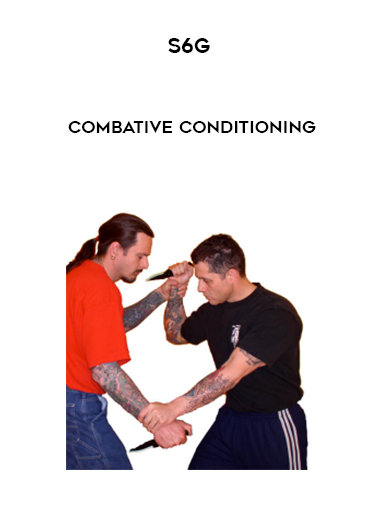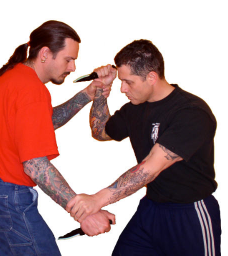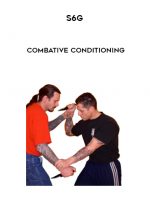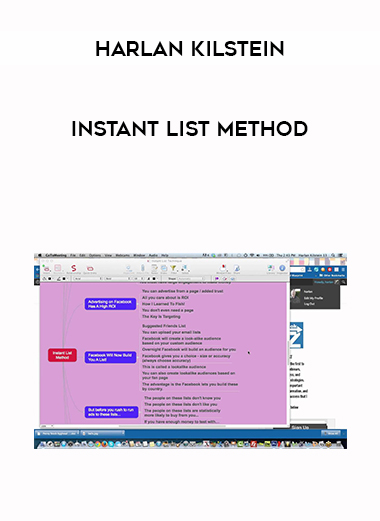
S6G – Combative Conditioning
Combat Conditioning is a very important component of mixed martial arts and reality based self defensetraining. As a matter of fact, Combat Conditioning can make the difference between winning and losing a street fight. When I talk about combat conditioning, I am referring to the physical and psychological development of a martial artists, self defense technician or fighter so he can achieve maximum performance in a combat situation. Keep in mind that Combat Conditioning is a slow and arduous process that will take a considerable amount of time. It will not happen over night! However, if you are serious about achieving your combat conditioning goals then it can be accomplished.
In this article, I am only going to address combat conditioning strictly on a physical level. If you would like to learn about psychological combat conditioning, please see my war machine book or war machine audio book.
Combat Conditioning and Physical Fitness
As I have mentioned in many of my self defense books, if you are going to achieve serious combat conditioning, you must be physically fit. It’s that simple. In fact, you will never master street fighting tools and skills unless you’re in excellent physical shape. On the average, you will have to spend more than an hour a day to achieve maximum combat conditioning. There is no escaping the fact that combat conditioning and physical fitness go hand in hand. In Contemporary Fighting Arts combat conditioning on physical level is comprised of three broad components:
“Before you begin a combat conditioning program, make certain that you have been cleared by your doctor. Since there is always some risk involved in self defense training and because each person is unique, it is important that before beginning any type of training program, you should have a complete physical examination by your physician.”
Combat Conditioning and Cardio Training
The cardiorespiratory systems includes the heart, lungs and circulatory system, which undergoes tremendous stress during the course of a street fight. So you’re going to have to run, jog, bike, swim, or skip rope to develop sound cardiorespiratory conditioning. Each aerobic workout should last a minimum of thirty minutes and be performed at least four times per week.
Running is one of the best ways to get into top physical condition. Running on a consistent basis improves wind capacity, endurance, circulation, and muscle tone. It strengthens the legs, burns a significant amount of calories, and stimulates the metabolism. Running sessions should always start with a brisk jog, working up to a faster pace. Remember to start off slowly and progressively build up speed. Make it a goal to run a minimum of five times per week for a duration of approximately fifty minutes. Later on you can consider adding hill or step running into your training routine.
“Running is by far one of the best combat conditioning exercises you can perform.”
Running style is another important consideration. Avoid stomping on the ground. Try running lightly and rhythmically with your arms and shoulders relaxed. Let your feet glide across the floor. Running should be practically silent. In fact, if you hear your feet hit the ground you’ll know that your running incorrectly. Every running session should include the following stages: warm-up; main workout; cool down; and stretches. And always try to buy the best running shoes that you can afford. Your feet will thank you later.
If it is possible, try to run in the morning. This is important for the following reasons:
• The air is usually cleaner.
• During the hot summer months its cooler in the morning hours.
• There’s more privacy.
• Its quieter.
• It accelerates your metabolism for the rest of the day.
• Your aerobic workout is taken care of so you can go about your day with peace of mind.
• You are mentally cleansed and energized for the rest of the day.
Dressing correctly for your run is also very important. Here are some important points to consider:
• Always wear clothes that doesn’t restrict your movement.
• Always wear a good pair of running shoes.
• In the summer months, dress to keep cool and comfortable.
• In the winter months, dress warmly. Sweat pants, sweat shirts, wind breaker, gloves, etc.
• Wear light or bright colors for maximal visibility.
Combat Conditioning and Weight Training
The second component of combat conditioning is the muscular skeletal system. In the streets, the strong survive and the rest go to the morgue. You have got to strengthen your bones and muscles to withstand the rigors of hand to hand combat. This can be accomplished through a combat conditioning program which includes progressive resistance (weight training) and perhaps some calisthenics.
“When it comes to combat conditioning, calisthenics are good, but nothing beats weight training.“
When it comes to combat conditioning, calisthenics are good, but nothing beats weight training. So you will need to lift iron on a regular basis. Its that simple. Ill be the first one to admit that weight training is not easy work. Its time consuming and can be very uncomfortable at times. Nevertheless, lifting weights serves two major purposes for effective combat conditioning. One, its the only effective way of developing and shaping your body into a formidable physique. Two, it strengthens the body for the tremendous strain of fighting.
There are four general principles that lay the foundation of an effective weight training program. They are:
1) An effective weight-training program must progressively overload your muscles.
2) As your muscles become stronger, the resistance must be increased.
3) Strength and size gains come quicker from fewer reps and heavy weights.
4) Your muscles must be given sufficient time to recuperate from training.
When lifting weights, be certain to maintain proper form and execute all of your movements in a smooth and controlled fashion. If you are unfamiliar with a particular exercise, don’t be apprehensive to ask a certified fitness instructor for assistance. See my war machine bookand war machine II: combat conditioning DVD.
Muscular flexibility is another important component of combat conditioning. You need a stretching program designed to loosen up every major muscle group. Remember that you can’t kick, punch, ground fight, or otherwise execute effective street fighting techniques if you are “tight” or inflexible.
Stretching on a regular basis will increase the muscle’s range of motion, improve circulation, reduce the possibilities of an injury, and relieve tension. Stretching should be performed in a slow and controlled manner. Always hold your stretch for a minimum of sixty seconds and avoid all ballistic (bouncing) movements. Don’t forget to always stretch before and after your combat conditioning sessions. Here are six combat conditioning stretches to help get you started:
Neck Stretch – From a comfortable standing position, slowly tilt your head to the right side of your neck, holding it for a count of twenty. Then tilt your head to the left side for approximately twenty seconds. Stretch each side of the neck at least three times.
Triceps Stretch – From a standing position, keep your knees slightly bent, extend your right arm overhead, hold the elbow of your right arm with your left hand and slowly pull your right elbow to the left. Keep your hips straight as you gently stretch your triceps for thirty seconds. Repeat this stretch for the other arm.
Hamstring Stretch – From a seated position, extend your right leg in front of you with your toe pointing to the ceiling. Place the sole of your left foot in the inside of your extended leg. Gently lean forward at the hips and stretch out the hamstrings of your right leg. Hold this position for a minimum of sixty seconds. Switch legs and repeat the stretch.
Spinal Twist – From a seated position, extend your right leg in front of you. Raise your left leg and place it to the outside of your right leg. Place your right elbow on the outside of your left thigh. Stabilize your stretch with your elbow and twist your upper body and head to your left side. Breath naturally and hold this stretch for a minimum of thirty seconds. Switch legs and repeat this stretch for the other side.
Quad Stretch – Assume a sitting position with your hamstring folded and resting on top of your calves. Your toes should be pointed behind you, and your instep should be flush with the ground. Sit comfortably into the stretch and hold for a minimum of thirty seconds.


































Reviews
There are no reviews yet.